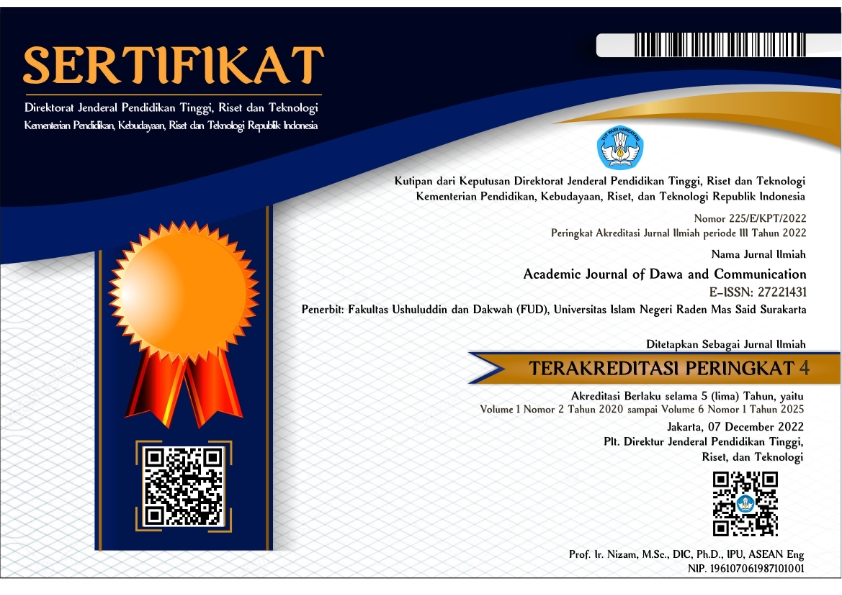Author Guidelines
A. General Requirements
The article must be scientific, either based on the empirical research or conceptual ideas. The content of the article have not published yet in any Journal, and should not be submitted simultaneously to another Journal. Article should not be part of fully one chapter of the theses or dissertation.
B. Writing Rules
Article must be in the range between 15-20 pages, not including title, abstract, keywords, and bibliography. Article consisting of the various parts: i.e. title, the author's name(s) and affiliation(s), abstract (150 words), Keywords (3-5 words), introduction, description and analysis, conclusion, and bibliography.
1. Title should not be more than 15 words
2. Author s name(s) should be written in the full name without academic title (degree), and completed with institutional affiliation(s) as well as corresponding address (e-mail address).
3. Abstract consisting of the discourses of the discipline area; the aims of article; methodology (if any); research finding; and contribution to the discipline of areas study. Abstract should be written in English.
4. Introduction
The introduction should be clear and provide the legal issue to be discussed in the manuscript. Before the objective, author should provide an adequate background, and very short literature survey in order to record existing solutions, to show in which is the best of previous researchers, to show what do you hope to achieve (to show the limitation), and to show the scientific merit or novelties of the manuscript. At the end, you should explain the urgency and clearly state aims of your study. At the end, you should explain the urgency and clearly state aims of your study and mention problem of the research in this section.
5. Research Methods
This method is written in descriptive and should provide a statement regarding the methodology of the research, include the type of research, research approach, a source of data and analysis method. The author should explain the mechanism to analyze the legal issue. This method as much as possible to give an idea to the reader through the method used, this method is optional, only for an original research article.
6. Results and Discussion
Results should be clear and concise. Discussion should explore the significance of the results of the work, not repeat them. Avoid extensive citations and discussion of published literature. More details see journal template!
7. Conclusion
The main conclusions of the study may be presented in a short Conclusions section. The conclusion section should lead the reader to important matter of the manuscript.
8. All of the bibliography used should be written properly. More details see journal template!
9. Citation's style used is the American Psychological Association (APA) 6th Edition (we use APA 6th start from Volume 2, Number 2, December 2018) and should be written in the model of body note (author(s), year), following to these below examples:
a.Book
In the bibliography:
Tagliacozzo, E. (2013). The Longest Journey: Southeast Asian and the Pilgrimage to Mecca. New York: Oxford University Press.
In the citation:
(Tagliacozzo, 2013)
b.Edited book(s)
In the bibliography:
Pranowo, M. B. (2006). Perkembangan Islam di Jawa Menjadi Indonesia 13 Abad Eksistensi Islam di Bumi Nusantara, Komaruddin Hidayat dan Ahmad Gaus AF, eds., 406-444. Jakarta: Mizan dan Yayasan Festival Istiqlal.
In the citation:
(Pranowo, 2006)
c.E-book(s)
In the bibliography:
Sukanta, P.O., ed. (2014). Breaking the Silence: Survivors Speak about 1965-66 Violence in Indonesia (translated by Jemma Purdey). Clayton: Monash University Publishing. Diakses dari http://books.publishing.monash.edu/apps/bookworm/view/Breaking+the+Silence%3A+ Survivors+Speak+about+1965%E2%80%9366+Violence+in+Indonesia/183/OEBPS/cop. htm, tanggal 31 Maret 2016.
In the citation:
(Sukanta, 2014)
d.Article of the Journal
1) Printing Journal
In the bibliography:
Reid, A. (2016). Religious Pluralism or Conformity in Southeast Asia Cultural Legacy. Studia Islamika 22, 3: 387-404. DOI:......................................................................
In the citation:
(Reid, 2016)
2) E-Journal
In the bibliography:
Crouch, M. (2016). Constitutionalism, Islam and the Practice of Religious Deference: the Case of the Indonesian Constitutional Court. Australian Journal of Asian Law 16, 2: 1-15. http://papers.ssrn.com/sol3/papers.cfm?abstract_id=2744394 diakses 31 Maret 2016. DOI:................................
In the citation:
(Crouch, 2016)
10. In writing the citations would be better and suggested to use software of citation manager, like Mendeley, Zotero, End-Note, Ref-Works, Bib-Text, and so forth, with following standard of American Psychological Association 6t Edition.
11. Arabic transliteration standard used International Journal of Middle Eastern Studies. For detailed transliteration could be seen at here.
12. Article must be free from plagiarism; through attached evidence (screenshot) that article has been verified through anti-plagiarism software, but not limited to the plagiarism checker (plagramme.com).
C. Commitment to Antiplagiarism
All submitted manuscripts will be double-checked for plagiarism using at least two anti-plagiarism softwares and Academic Journal of Da'wa and Communication unique detection of plagiarism. The submitted manuscripts written under the same 100% or less condition as other published manuscripts would be blacklisted.
D. Authors should:
- Responsible for everything published in the journal, and should therefore take all reasonable steps to ensure the quality of the material, recognizing the aim and standard of the journal.
- Present an accurate account of the work performed as well as an objective discussion of its significance. The information should be represented accurately in the paper. A paper should contain sufficient detail and references to permit others to replicate the work. Knowingly inaccurate statements constitute unethical behaviour and are unacceptable.
- Ensure that they have written entirely original works, and if the authors have used the work and/or words of others that this has been appropriately cited or quoted.
- Not in general publish manuscripts describing essentially the same research in more than one journal or primary publication. Submitting the same manuscript to more than one journal concurrently constitutes unethical publishing behaviour and is unacceptable.
- Give proper acknowledgment of the work of others. Authors should cite publications that have been influential in determining the nature of the reported work.
- Listed all those who have made significant contributions should be listed as co-authors. Where there are others who have participated in certain substantive aspects of the research project, they should be acknowledged or listed as contributors. The corresponding author should ensure that all appropriate co-authors and no inappropriate co-authors are included on the paper, and that all co-authors have seen and approved the final version of the paper and have agreed to its submission for publication.
- Notify the journal editor or publisher and cooperate with the editor to retract or correct the paper, when an author discovers a significant error or inaccuracy in his/her own published work.

















